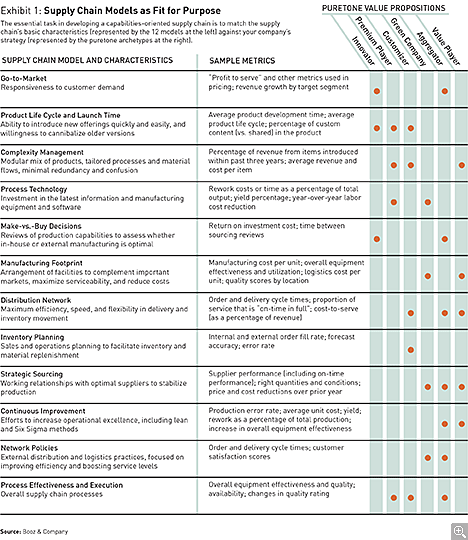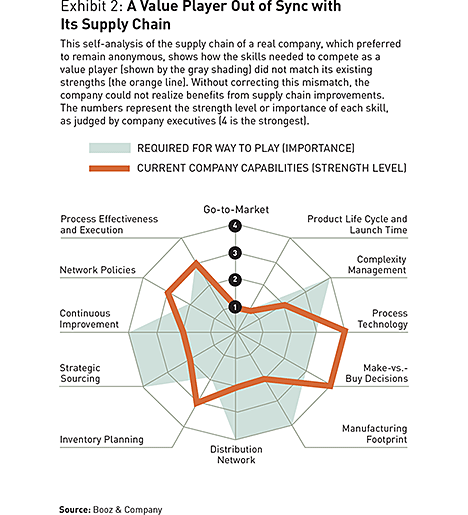Designing the Right Supply Chain
Companies that align their operations to their strategy unleash superior performance.
When a company’s supply chain capabilities are directly aligned with its enterprise strategy, the results tend to be superior performance and a strong market position. Among the organizations that have demonstrated this is the Girl Scouts of the USA, which annually funds about two-thirds of its operating costs by enlisting its members, mostly girls age 9 to 14, to sell its well-known cookies. In 2011, the organization simplified its product line from 28 varieties to 11, with special emphasis on the six most popular items (Thin Mints, Samoas, Tagalongs, Trefoils, Do-Si-Dos, and Lemon Chalet Crèmes). Variety beyond a handful of perennial favorites did not matter to customers who were primarily looking to support their community Girl Scout organization. Simplicity enabled the Girl Scouts to improve the effectiveness of a supply chain strategy that depends on a distributed, young volunteer “workforce” that comes together for only a few months annually. Suddenly, the tasks involved in this once-a-year capability—allocating product among troops and individual Girl Scouts, tracking sales to replenish the troop’s inventory, and getting the right varieties of cookies to each participant—were all much easier. Not only did the change allow the Girl Scouts to be more effective, focusing their efforts on sales techniques rather than balancing inventory, but it also taught the young sales force “about supply chain issues and the need for efficiencies,” as Denise Pesich, Girl Scouts vice president for communications, said in an article on the Atlantic website.
The Girl Scouts concentrated on simplifying their supply chain to better support their mission, but leaders at companies such as Procter & Gamble (P&G), Coca-Cola, Amazon, or Walmart face a different form of the same problem: the sheer complexity of supply chain management for multi-category, multi-market enterprises. Their need to align supply chain solutions to more effectively support their company’s strategies is even more critical. And yet, a true strategic fit between enterprise and supply chain strategy is all too rare in the business world. Few companies have been able to marry their strategic goals with their operational capabilities. Their supply chain leaders struggle with a myriad of often conflicting demands from marketing, sales, engineering, manufacturing, and procurement. With little agreement across the organization—and no way to make or manage trade-offs—issues like cost, customization, speed, and price are rarely addressed in an effective cross-functional way.
Conversely, when a company is strategically coherent, its supply chain can be a linchpin of superior performance. For example, clothing retailer Nordstrom uses extremely sophisticated inventory and product life-cycle management capabilities to move products through its channels in half the time of Macy’s or Saks Fifth Avenue, cycling through each season’s new fashions more efficiently and effectively than its competitors. This is a major factor in Nordstrom’s consistent ability to outpace its rivals in profit margins and EBIT as a percentage of sales.
Would Nordstrom’s supply chain model work for your company? Probably not. Every successful company should have an operational design and management style tailored to its own purpose and strategy. At Booz & Company, we often divide strategies into categories based on archetypal approaches to the market, which we call puretones. These are some of the most commonly found puretones in global enterprises.
• Innovators are known for introducing new and creative products and services to the market; they need to balance their forward-looking creativity with practicality and user acceptance. Apple, 3M, P&G, and Honeywell are noteworthy examples.
• Premium players offer high-end products or services and superior customer service. Their differentiated position allows them to demand a higher price. Success as a premium player is not as easy as it might seem; it requires discerning and managing the costs of increased quality and attentiveness. Nordstrom, Herman Miller, and BMW are successful premium players.
• Customizers make use of customer intelligence to offer tailored products or services to particular segments of their market. They can flexibly adapt to changing demand. The challenge they face is balancing this flexibility with profitability. Well-known customizers include Dell, Burger King (“Have it your way”), and direct-sale cosmetics firms like Avon and Natura.
• Green companies are an increasingly common form of reputation player—building on the principle that sustainability is good business. They stake out a customer base by addressing the supply chain needs of low-carbon-emissions and toxin-free products; they are ready to invest in differentiated technologies. They must learn to manage a green supply chain at competitively low costs. Some differentiated green companies are GE, Seventh Generation, and automakers such as Toyota and GM (those building businesses around hybrid or electric cars).
• Aggregators combine offerings from a variety of sources, providing people the convenience of a one-stop solution. They may manufacture some products and outsource or subcontract for others. Their concerns are related to differentiation: They must ensure that the value of their own contribution is recognized. Some examples of aggregators are Amazon, eBay, and W.W. Grainger.
• Value players develop low-cost supply chains and pass savings on to customers. They may also leverage savings to make additional investments elsewhere. They soon discover that to avoid being commoditized, they cannot let low cost affect quality or service. Ikea, Walmart, Southwest Airlines, Tata Motors (maker of the Nano), and McDonald’s are all value players.
In real life, of course, every successful company is unique. The most successful strategies tend to be combinations of puretones, representing highly distinctive ways to play in the market. Amazon’s value proposition, for example, involves being an aggregator, a value player, and an innovator. It sells products from extremely varied sources at very low prices, using its own form of online marketing and innovative logistics. Elements of all three puretones are essential to its strategy, and are reflected in its value chain.
For each of the puretone archetypes, a different mix of supply chain characteristics is required. Thus, in designing your supply chain, it’s helpful to know which puretones represent significant elements of your company’s way to play. Typically, a company can focus investment on only three to five ways to improve its supply chain at one time. Exhibit 1 shows 12 of these opportunities for leverage, and the puretone value propositions best matched to them. Companies don’t have to excel at everything; they can determine the kind of organization they want to be and then develop a supply chain agenda that matches this aspiration.
If your company is a value player, you will benefit from supply chains that emphasize complexity management; make sure every new product conforms to existing manufacturing processes and, thus, can be offered at a relatively low price. Manufacturing footprints should also be a priority. Place factories in developing nations, and adopt less-expensive logistics approaches, such as railroads and container shipping. Under the rubric of strategic sourcing, cultivate long-lasting supplier relationships, with high levels of cooperation, so all stages of the supply chain can be constantly improved. Indeed, continuous improvement should be an overall area of emphasis: Implement lean manufacturing techniques in all your facilities. Unfortunately, many value players have organized their supply chains in other ways (see Exhibit 2).
Alignment between your strategy and your supply chain has one final benefit. Because each form of leverage is associated with different metrics, it gives you an effective way to measure the ongoing health of your supply chain. Keeping track of the right metrics is crucial, helping to differentiate you from competitors on a daily basis. As an enterprise with an eye on its value proposition, you can reap substantial rewards from having this sort of very capable supply chain. ![]()
Reprint No. 00160
Author profiles:
- Richard Kauffeld is a partner with Booz & Company based in New York. He develops supply chain and channel strategies and supporting capabilities to enable growth and efficiency for consumer products companies and retailers.
- Curt Mueller is a partner with Booz & Company based in Chicago. He specializes in value creation through supply chain strategy and building operations capabilities for consumer, retail, and industrial companies.
- Adam Michaels is a principal with Booz & Company based in New York. He specializes in product launch strategies and supply chain solutions for consumer product manufacturers and media companies.
- For an interactive online tool that can help you diagnose the value of your supply chain in light of your company’s strategy, see www.strategyand.pwc.com/SCCprofiler.





